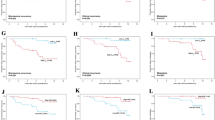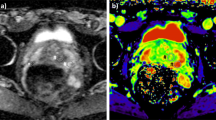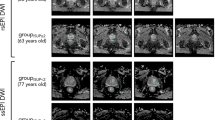Abstract
Angiogenesis is an integral part of benign prostatic hyperplasia, is associated with prostatic intraepithelial neoplasia and is a key factor in the growth and metastasis of prostate cancer. This review focuses on ultrasound and dynamic MRI in the evaluation of prostate cancer angiogenesis, and compares these techniques to functional CT and hydrogen magnetic resonance spectroscopic imaging. Image-based evaluation of angiogenesis in the prostate has established clinical roles in lesion detection, tumor staging and the detection of suspected tumor recurrence. One limitation of all these imaging techniques, however, is inadequate lesion characterization, particularly in differentiating prostatitis from cancer in the peripheral zone of the prostate, and in distinguishing between benign prostatic hyperplasia and central-gland tumors. Ultimately, local availability, expertise and the need to minimize patients' radiation burden will influence which technique is used in prostatic evaluations.
This is a preview of subscription content, access via your institution
Access options
Subscribe to this journal
Receive 12 print issues and online access
$209.00 per year
only $17.42 per issue
Buy this article
- Purchase on Springer Link
- Instant access to full article PDF
Prices may be subject to local taxes which are calculated during checkout






Similar content being viewed by others
References
Izawa JI and Dinney CP (2001) The role of angiogenesis in prostate and other urologic cancers: a review. CMAJ 164: 662–670
Ferrer FA et al. (1998) Angiogenesis and prostate cancer: in vivo and in vitro expression of angiogenesis factors by prostate cancer cells. Urology 51: 161–167
Jackson MW et al. (1997) Vascular endothelial growth factor (VEGF) expression in prostate cancer and benign prostatic hyperplasia. J Urol 157: 2323–2328
Haggstrom S et al. (1999) Testosterone induces vascular endothelial growth factor synthesis in the ventral prostate in castrated rats. J Urol 161: 1620–1625
Jain RK et al. (1998) Endothelial cell death, angiogenesis, and microvascular function after castration in an androgen-dependent tumor: role of vascular endothelial growth factor. Proc Natl Acad Sci USA 95: 10820–10825
Stefanou D et al. (2004) Expression of vascular endothelial growth factor (VEGF) and association with microvessel density in benign prostatic hyperplasia and prostate cancer. In Vivo 18: 155–160
Sinha AA et al. (2004) Microvessel density as a molecular marker for identifying high-grade prostatic intraepithelial neoplasia precursors to prostate cancer. Exp Mol Pathol 77: 153–159
Bono AV et al. (2002) Microvessel density in prostate carcinoma. Prostate Cancer Prostatic Dis 5: 123–127
Bigler SA et al. (1993) Comparison of microscopic vascularity in benign and malignant prostate tissue. Hum Pathol 24: 220–226
Offersen BV et al. (1998) Immunohistochemical determination of tumor angiogenesis measured by the maximal microvessel density in human prostate cancer. APMIS 106: 463–469
Deering RE et al. (1995) Microvascularity in benign prostatic hyperplasia. Prostate 26: 111–115
Weidner N et al. (1993) Tumor angiogenesis correlates with metastasis in invasive prostate carcinoma. Am J Pathol 143: 401–409
Brawer MK et al. (1994) Predictors of pathologic stage in prostatic carcinoma. The role of neovascularity. Cancer 73: 678–687
Borre M et al. (1998) Microvessel density predicts survival in prostate cancer patients subjected to watchful waiting. Br J Cancer 78: 940–944
Newman JS et al. (1995) Prostate cancer: diagnosis with color Doppler sonography with histologic correlation of each biopsy site. Radiology 195: 86–90
Shigeno K et al. (2000) The role of colour Doppler ultrasonography in detecting prostate cancer. BJU Int 86: 229–233
Cornud F et al. (2000) Endorectal color Doppler sonography and endorectal MR imaging features of nonpalpable prostate cancer: correlation with radical prostatectomy findings. AJR Am J Roentgenol 175: 1161–1168
Halpern EJ and Strup SE (2000) Using gray-scale and color and power Doppler sonography to detect prostatic cancer. AJR Am J Roentgenol 174: 623–627
Harvey CJ et al. (2001) Developments in ultrasound contrast media. Eur Radiol 11: 675–689
Harvey CJ et al. (2002) Advances in ultrasound. Clin Radiol 57: 157–177
Goossen TE et al. (2003) The value of dynamic contrast enhanced power Doppler ultrasound imaging in the localization of prostate cancer. Eur Urol 43: 124–131
Miles KA (2002) Functional computed tomography in oncology. Eur J Cancer 38: 2079–2084
Collins DJ and Padhani AR (2004) Dynamic magnetic resonance imaging of tumor perfusion. Approaches and biomedical challenges. IEEE Eng Med Biol Mag 23: 65–83
Sedelaar JP et al. (2001) Three-dimensional grayscale ultrasound: evaluation of prostate cancer compared with benign prostatic hyperplasia. Urology 57: 914–920
Strohmeyer D et al. (2001) Contrast-enhanced transrectal color Doppler ultrasonography (TRCDUS) for assessment of angiogenesis in prostate cancer. Anticancer Res 21: 2907–2913
Shigeno K et al. (2003) Transrectal colour Doppler ultrasonography for quantifying angiogenesis in prostate cancer. BJU Int 91: 223–226
Jager GJ et al. (1997) Dynamic TurboFLASH subtraction technique for contrast-enhanced MR imaging of the prostate: correlation with histopathologic results. Radiology 203: 645–652
Liney GP et al. (1999) In vivo magnetic resonance spectroscopy and dynamic contrast enhanced imaging of the prostate gland. NMR Biomed 12: 39–44
Turnbull LW et al. (1999) Differentiation of prostatic carcinoma and benign prostatic hyperplasia: correlation between dynamic Gd-DTPA-enhanced MR imaging and histopathology. J Magn Reson Imaging 9: 311–316
Padhani AR et al. (2000) Dynamic contrast enhanced MRI of prostate cancer: correlation with morphology and tumour stage, histological grade and PSA. Clin Radiol 55: 99–109
Engelbrecht MR et al. (2003) Discrimination of prostate cancer from normal peripheral zone and central gland tissue by using dynamic contrast-enhanced MR imaging. Radiology 229: 248–254
Buckley DL et al. (2004) Prostate cancer: evaluation of vascular characteristics with dynamic contrast-enhanced T1-weighted MR imaging—initial experience. Radiology 233: 709–715
Kiessling F et al. (2004) Simple models improve the discrimination of prostate cancers from the peripheral gland by T1-weighted dynamic MRI. Eur Radiol 14: 1793–1801
Schlemmer HP et al. (2004) Can preoperative contrast-enhanced dynamic MR imaging for prostate cancer predict microvessel density in prostatectomy specimens? Eur Radiol 14: 309–317
Zakian KL et al. (2005) Correlation of proton MR spectroscopic imaging with Gleason score based on step-section pathologic analysis after radical prostatectomy. Radiology 234: 804–814
Halpern EJ et al. (2001) Prostate cancer: contrast-enhanced US for detection. Radiology 219: 219–225
Frauscher F et al. (2002) Comparison of contrast enhanced color Doppler targeted biopsy with conventional systematic biopsy: impact on prostate cancer detection. J Urol 167: 1648–1652
Unal D et al. (2000) Three-dimensional contrast-enhanced power Doppler ultrasonography and conventional examination methods: the value of diagnostic predictors of prostate cancer. BJU Int 86: 58–64
Namimoto T et al. (1998) The value of dynamic MR imaging for hypointensity lesions of the peripheral zone of the prostate. Comput Med Imaging Graph 22: 239–245
Tanaka N et al. (1999) Diagnostic usefulness of endorectal magnetic resonance imaging with dynamic contrast-enhancement in patients with localized prostate cancer: mapping studies with biopsy specimens. Int J Urol 6: 593–599
Ogura K et al. (2001) Dynamic endorectal magnetic resonance imaging for local staging and detection of neurovascular bundle involvement of prostate cancer: correlation with histopathologic results. Urology 57: 721–726
Ito H et al. (2003) Visualisation of prostate cancer using dynamic contrast-enhanced MRI: comparison with transrectal power Doppler ultrasound. Br J Radiol 76: 617–624
van Dorsten FA et al. (2004) Combined quantitative dynamic contrast-enhanced MR imaging and 1H MR spectroscopic imaging of human prostate cancer. J Magn Reson Imaging 20: 279–287
Shukla-Dave A et al. (2004) Chronic prostatitis: MR imaging and 1H MR spectroscopic imaging findings—initial observations. Radiology 231: 717–724
Bloch BN et al. (2005) Non-invasive prostate tumor volumetry using parametrically analyzed dynamic contrast enhanced MRI (DCE-MRI): correlation with whole mount prostatectomy specimens—initial results. Magn Reson Med 13: 1941 (In press)
Pouliot J et al. (2004) Inverse planning for HDR prostate brachytherapy used to boost dominant intraprostatic lesions defined by magnetic resonance spectroscopy imaging. Int J Radiat Oncol Biol Phys 59: 1196–1207
Padhani AR et al. (2001) Effects of androgen deprivation on prostatic morphology and vascular permeability evaluated with MR imaging. Radiology 218: 365–374
Smith DM and Murphy WM (1994) Histologic changes in prostate carcinomas treated with leuprolide (luteinizing hormone-releasing hormone effect). Distinction from poor tumor differentiation. Cancer 73: 1472–1477
Civantos F et al. (1996) Histopathological effects of androgen deprivation in prostatic cancer. Semin Urol Oncol 14: 22–31
Eckersley RJ et al. (2002) Quantitative microbubble enhanced transrectal ultrasound as a tool for monitoring hormonal treatment of prostate carcinoma. Prostate 51: 256–267
Bostwick DG (2000) Immunohistochemical changes in prostate cancer after androgen deprivation therapy. Mol Urol 4: 101–107
Matsushima H et al. (1999) Correlation between proliferation, apoptosis, and angiogenesis in prostate carcinoma and their relation to androgen ablation. Cancer 85: 1822–1827
Harvey CJ et al. (2001) Functional CT imaging of the acute hyperemic response to radiation therapy of the prostate gland: early experience. J Comput Assist Tomogr 25: 43–49
Huber P et al. (1999) Synergistic interaction of ultrasonic shock waves and hyperthermia in the Dunning prostate tumor R3327-AT1. Int J Cancer 82: 84–91
Boni RA et al. (1997) Laser ablation-induced changes in the prostate: findings at endorectal MR imaging with histologic correlation. Radiology 202: 232–236
Osman YM et al. (2000) Correlation between central zone perfusion defects on gadolinium-enhanced MRI and intraprostatic temperatures during transurethral microwave thermotherapy. J Endourol 14: 761–766
Sedelaar JP et al. (2000) The application of three-dimensional contrast-enhanced ultrasound to measure volume of affected tissue after HIFU treatment for localized prostate cancer. Eur Urol 37: 559–568
Takeda M et al. (2002) Value of multi-sectional fast contrast-enhanced MR imaging in patients with elevated PSA levels after radical prostatectomy. AJR Am J Roentgenol 178 (Suppl): 97
Coakley FV et al. (2004) Endorectal MR imaging and MR spectroscopic imaging for locally recurrent prostate cancer after external beam radiation therapy: preliminary experience. Radiology 233: 441–448
Author information
Authors and Affiliations
Corresponding author
Ethics declarations
Competing interests
The authors declare no competing financial interests.
Rights and permissions
About this article
Cite this article
Padhani, A., Harvey, C. & Cosgrove, D. Angiogenesis imaging in the management of prostate cancer. Nat Rev Urol 2, 596–607 (2005). https://doi.org/10.1038/ncpuro0356
Received:
Accepted:
Issue Date:
DOI: https://doi.org/10.1038/ncpuro0356
This article is cited by
-
Motion model ultrasound localization microscopy for preclinical and clinical multiparametric tumor characterization
Nature Communications (2018)
-
A direct comparison of contrast-enhanced ultrasound and dynamic contrast-enhanced magnetic resonance imaging for prostate cancer detection and prediction of aggressiveness
European Radiology (2018)
-
Feasibility study of CT perfusion imaging for prostate carcinoma
European Radiology (2014)
-
Bildgebung beim Prostatakarzinom
Der Onkologe (2013)



